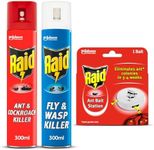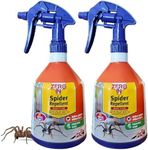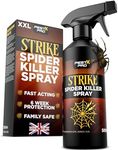Buying Guide for the Best Spider Killers
Choosing the right spider killer can be a daunting task, especially with the variety of products available on the market. The key to making the right choice is understanding your specific needs and the environment in which you plan to use the product. Whether you are dealing with a minor spider problem or a more significant infestation, knowing the key specifications of spider killers will help you make an informed decision. Here are some important factors to consider when selecting a spider killer.Type of Spider KillerSpider killers come in various forms, including sprays, traps, powders, and electronic devices. Sprays are great for immediate results and can be used directly on spiders or in areas where they are commonly found. Traps are useful for monitoring and capturing spiders over time. Powders can be applied in hard-to-reach areas and are effective for long-term control. Electronic devices use ultrasonic waves to repel spiders. Choose the type based on your preference for immediate action versus long-term control and the specific areas you need to treat.
Active IngredientsThe active ingredients in spider killers determine their effectiveness and safety. Common active ingredients include pyrethroids, which are synthetic chemicals that mimic natural insecticides, and essential oils like peppermint or citrus, which are natural repellents. Pyrethroids are highly effective but can be toxic to pets and humans if not used properly. Essential oils are safer but may require more frequent application. Consider the safety of your household, especially if you have pets or children, when choosing a product with specific active ingredients.
Coverage AreaThe coverage area refers to the amount of space a spider killer can effectively treat. Sprays and powders usually specify the square footage they can cover, while traps and electronic devices indicate the area they can protect. For large infestations or bigger areas, you may need a product with a larger coverage area. For smaller spaces or targeted treatments, a product with a smaller coverage area may suffice. Assess the size of the area you need to treat to determine the appropriate coverage.
Residual EffectThe residual effect is the duration a spider killer remains effective after application. Products with a long residual effect continue to kill or repel spiders for weeks or even months, reducing the need for frequent reapplication. However, these products may also pose a longer-term risk to pets and humans. Shorter residual effects require more frequent application but may be safer for regular use. Consider how often you are willing to reapply the product and the safety implications for your household.
Ease of UseEase of use refers to how simple and convenient it is to apply the spider killer. Sprays are generally easy to use and provide immediate results, while powders may require more careful application to avoid inhalation. Traps and electronic devices are typically straightforward to set up and maintain. Choose a product that fits your comfort level with application and maintenance. If you prefer a hands-off approach, traps or electronic devices might be the best option.
SafetySafety is a crucial consideration, especially if you have pets or children. Some spider killers contain chemicals that can be harmful if ingested or inhaled. Look for products that are labeled as safe for use around pets and children, or consider natural alternatives like essential oil-based products. Always follow the manufacturer's instructions for safe application and storage. Prioritize safety to ensure that the spider killer effectively addresses your problem without posing a risk to your household.
















